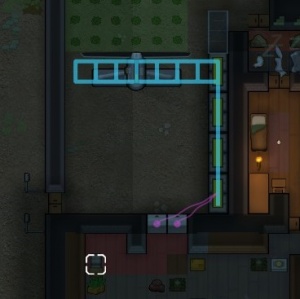Difference between revisions of "Battery"
(added image) |
(Discharge rate is in units of power (Watts), energy storage is in units of Wd (Watt-days)) |
||
| Line 31: | Line 31: | ||
* Excess generated power is distributed evenly among all non-full, connected batteries, charging all batteries at the same rate. | * Excess generated power is distributed evenly among all non-full, connected batteries, charging all batteries at the same rate. | ||
* If power consumption exceeds power generation, all non-empty, connected batteries will deplete at the same rate to fill the power gap. | * If power consumption exceeds power generation, all non-empty, connected batteries will deplete at the same rate to fill the power gap. | ||
| − | * Small self-discharge of 5W | + | * Small self-discharge rate of 5W. In other words, a battery which is full when uninstalled or disconnected will drop to 300Wd after an in-game year (60 days). |
Revision as of 17:13, 30 May 2019
Battery
Stores electricity when there is excess power and yields it when there is not. Warning - charged batteries tend to explode when heated or wet.
Base Stats
Building
- Size
- 1
- Placeable
- Yes
- Cover Effectiveness
- 40%
- Efficiency
- Expression error: Unrecognized punctuation character "%".%
A battery stores electricity, up to 600 Wd (Watt-days), when there is surplus power, and provides the stored power back to the grid when there's a deficit. A power deficit is often the result from wind turbines not getting enough wind or from solar generators not getting enough light, at night or during an eclipse. Although connected devices stop working, batteries do not lose their stored charge during a solar flare.
A device which uses power can connect to a battery without the use of a conduit if the battery and the device are within 6 tiles of one another, even if they are separated by a wall. However, batteries cannot connect to each other or to a generator in this way. They must be touching or connected by a conduit to share power. A switch can connect directly to a battery. However, devices can't connect directly to a switch, so a switch needs to have a conduit between it and the devices in order to function.
Your currently installed power networks will be highlighted when you select "Power" from the Architect menu.
Charging Features
- Stores up to 600Wd of energy.
- Efficiency of 50% -- takes twice as much energy to charge than it can store.
- Excess generated power is distributed evenly among all non-full, connected batteries, charging all batteries at the same rate.
- If power consumption exceeds power generation, all non-empty, connected batteries will deplete at the same rate to fill the power gap.
- Small self-discharge rate of 5W. In other words, a battery which is full when uninstalled or disconnected will drop to 300Wd after an in-game year (60 days).
Moving and Storing
- A battery can be uninstalled, converting it to a 'minified' version in a box. It's categorized as a furniture item and will be hauled to an appropriate stockpile. It still retains its stored charge while boxed. The battery can be installed again when needed.
- Batteries can be moved by reinstalling them. They do not lose their charge during the move, making them a portable power source.
Hazards
- Conduits can be faulty, and a battery can amplify the effect of a short circuit, causing all of the stored energy to explode at the faulty power conduit. This event is well-known to players by its envelope notification, the "Zzztt" event.
- When a short circuit strikes, more stored power will create a larger explosion, which can be devastating if a large number of batteries discharge at once. Mitigate this damage by creating separate battery networks using Power switches. Disconnect the batteries when charged, and only connect the batteries when they are needed (such as immediately after the other batteries short out).
- A battery can be disconnected from the grid by reinstalling it away from the grid or by using a switch to isolate it from the grid. A disconnected battery is not affected by short circuits.
- Batteries are highly likely to explode and catch fire when exposed to rain.
- Batteries can catch fire when exposed to too much heat.

